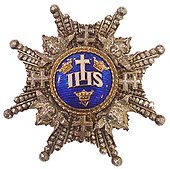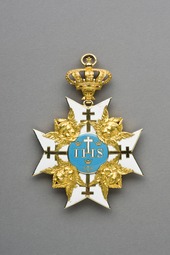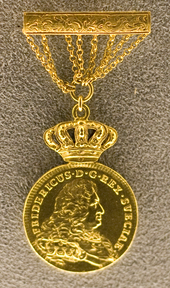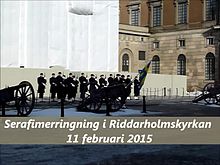Royal Order of Seraphines

The Royal Seraphine Order ( sv. Kungliga Serafimerorden ), also called The Blue Ribbon (Det blå bandet) , is the household and highest order of merit in the Kingdom of Sweden .
history
The Order of the Seraphines was founded on the 72nd birthday of the Swedish King Friedrich I from the House of Hessen-Kassel on April 23, 1748. At the same time as the Seraphine Order, King Friedrich created the so-called "Order System", in that knights of the Seraphine Order were given the title of "Knight and Commander of the Order of His Royal Majesty" (Riddare och kommendör av Kunglig Majesty's Order) , which means that they are also Great Crosses of the Northern Star Order and of the Order of the Sword or vice versa, so that residents could only receive the Order of Seraphine if they had previously held one of the grand crosses of the above-mentioned awards. The foundation naturally conceived a glorious past of the order, which was to be founded in the 13th century by King Magnus I Ladulås, and limited the number of local knights (princes of the royal family as knights by birth not counting) to 24, later to 32 .
There are four possible ancestors of the Order of the Seraphines : the necklace of the Order of Salvator worn by Erik XIV , the necklace of the Agnus Dei order of King John III. , the Collane of the Jehovah Order of King Charles IX. and the Collane of the Order of Jesus of the kings Karl X. Gustav and Karl XI. These collans contained some elements of the chain of orders of the Seraphine Order, but since they were only allowed to be worn by kings and never received statutes, they cannot be regarded as medals.
In the case of the natives, the order was only given to men, high civil servants and the military with the rank of at least one lieutenant general , to clergymen who were bishops and were called "members", not knights. In the case of foreigners, it was only given to men who were heads of state, and in the case of monarchies also to crown princes and some princes. The royal princes of Sweden received it in their cradle when they were baptized , but were only allowed to put it on after confirmation and lost it when they left the royal family . Only the statutes of 1902, drawn up under King Oskar II , gave the queen the right to wear the Seraphine Order , but without admitting women to the religious community.
The knights had the duty to either work a few days a year in the Seraphin Hospital (Serafimerlasarettet) in Stockholm, which was founded in 1752, or to give it financial help. The renowned institution with great merits in medical research was closed in 1980.
In connection with the new constitution, which came into force in 1975, the awarding of all (state) Swedish medals, including the Order of the Seraphine, to nationals was abolished. This regulation was changed in 1995 to the effect that the royal family is exempt from it, so that the order now functions as a pure house order within Sweden. Since 1952, the princesses of Sweden were also admitted to the order with the title "Members". The Order of the Seraphine is then awarded to foreign heads of state and personalities of equal status, especially on the occasion of state visits.
Since 1975 Swedish citizens can only get the gold medal “For diligence and loyalty in the service of the Reich” (För nit och trohet i rikets tjänst) for 30 years of civil service (regardless of whether they worked as cleaning women and stokers , or ministers and generals) and various get other medals of merit (for work in the municipal and private sectors). The de facto abolition of the religious system paved the way for an unintended upswing in the medal system.
insignia
The insignia of the single-class seraphine order are the order cross, the breast star and the collar.
The order cross is a large golden Maltese cross with balls on the tips of the arms. The cross is white enamelled with a gold rim and has gold seraph heads in its corners. In the blue-lined middle medallion of the obverse is the cipher I H S (Iesus Hominum Salvator), which is raised by a white Latin cross and surrounded by three golden crowns (the Swedes, Goths and Vandals ). On all sides of the medallion in the middle, the arms of the order cross carry small patriarchal crosses . In the reverse, the medallion in the middle shows the cipher F R S( Fridericus Rex Sueciae ). The order cross is raised by a golden royal crown and carried on a light blue sash from the right shoulder to the left hip.
The order star is a large silver Maltese cross with seraph heads in the corners, with the same medallion in the middle as in the obverse of the order cross. The star is worn on the left chest. The stars were embroidered until around 1860.
Both the cross and the star could be awarded with diamonds.
The collar, which “only has to be put on according to special orders from His Majesty”, consists of eleven golden seraph heads and eleven blue enameled patriarchal crosses. It was very rarely given to foreigners.
The order also includes the extremely rare golden seraphine medal . It shows the bust of Frederick I, hangs on a crown and golden chains and was awarded to people who had made extraordinary contributions to the poor and sick. It was awarded twice throughout the 20th century. a. to Elsa Brändström . In 1974 the medal was placed at the direct disposal of the king, which means that it has since been awarded to Swedish citizens who can no longer receive the Order of the Seraphine. The obverse of the medal shows the bust of King Friedrich I with the inscription Fridericus D.G. Rex Sueciae. The medal has the collar of the Order of the Seraph in the lapel, Procederes Cum Principe Nectit 1748surrounded by the inscription . Inside the collar is the inscription Ordo Eq. Seraphin. Restauratus Natali Regis LXXIII. Copies of the medal from the time of King Frederick I of Hessen-Homburg are still in use,
The chapter of the order is common to all three orders of the "system" ( excluding the Wasa Order ) and consists of the order chancellor and vice-chancellor, treasurer, master of ceremonies, standard bearer, order bishop and herald .
Serafimerringningen
Until around 1820 all knights who died in Stockholm were buried in the Riddarholmskirche (Riddarholmskyrkan), where all kings up to Gustav V were buried. In this church, the coats of arms of the entrusted can still be found on the walls. Since the church is not a parish church, the bells are rung only on the day of the burial of every seraphine knight. The serafimer ringing ( Serafimerringningen in Swedish ), which lasts for a full hour from 12 p.m. to 1 p.m. , is accompanied by a ceremony in the church. Before that, the coat of arms is carried in a procession from Stockholm Palace to Riddarholm Church. There is an obligation to return the insignia after the death of every domestic and foreign knight. This also applies to the seraphine medal.
Known porters
literature
- Per Nordenvall: Kungliga Serafimerorden 1748–1998. Kungl Maj: ts medal. Stockholm 1998.
- HJ Kleberg (Ed.): Kungl. svenska riddarordnarna. Stockholm and Malmö 1935.
- Robert Södermark: Kungliga svenska riddareordnarna. Lund 1897.
- Erik Torstensson Uggla (ed.): Ordenskalender 1963. Stockholm 1963.
Web links
- Kungahuset.se - Order of Serafimer (Swedish)
Individual evidence
- ↑ Information on http://medalj.nu/ , accessed on July 19, 2014.
- ↑ Kungahuset: Serafimerringning.




